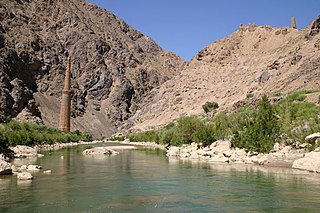
The Hari River or Herat River or Tejen River or Harirud is a river flowing 1,100 kilometres (680 mi) from the mountains of central Afghanistan to Turkmenistan, where it forms the Tejen oasis and disappears in the Karakum Desert. In its lower course, the river forms a northern part of the border between Afghanistan and Iran, and a southeastern part of the border between Turkmenistan and Iran.

Khuzestan Province is one of the 31 provinces of Iran. Its capital is the city of Ahvaz. Located in the southwest of the country, the province borders Iraq and the Persian Gulf, covering an area of 63,238 square kilometres (24,416 sq mi). Its capital is the city of Ahvaz. Since 2014, it has been part of Iran's Region 4.

Khorramshahr is a city in the Central District of Khorramshahr County, Khuzestan province, Iran, serving as capital of both the county and the district.

Ahvaz is a city in the Central District of Ahvaz County, Khuzestan province, Iran. It serves as capital of the province, the county, and the district. It is home to Persians, Arabs, Bakhtiaris, Dezfulis, Shushtaris, and others. Languages spoken in the area include Persian, Arabic, Luri and dialects such as Bakhtiari, Dezfuli and Shushtari.
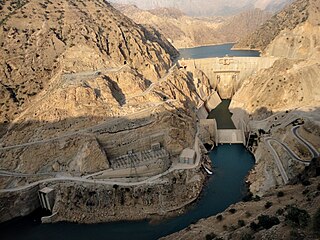
The Karun-3 dam is a hydroelectric dam on the Karun river located in the province of Khuzestan, Iran. It was built to help meet Iran's energy demands as well as provide seasonal flood control. The Karun river has the highest discharge slits and seasonal flooding in Iran.
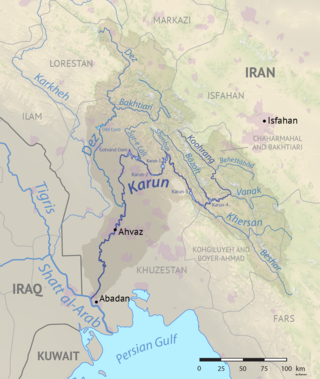
The Karun is the Iranian river with the highest water flow, and the country's only navigable river. It is 950 km (590 mi) long. The Karun rises in the Zard Kuh mountains of the Bakhtiari district in the Zagros Range, receiving many tributaries, such as the Dez and the Kuhrang. It passes through the city of Ahvaz, the capital of the Khuzestan Province of Iran, before emptying to its mouth into Arvand Rud.

The Sefid-Rud is a river, approximately 670 kilometres (416 mi) long, rising in the Alborz mountain range of northwestern Iran and flowing generally northeast to empty into the Caspian Sea at Rasht.

The Karun-4 Dam is an arch dam on the Karun River located 180 km southwest of Shahr-e-Kord in the province of Chaharmahal and Bakhtiari, Iran. The Karun has the highest discharge of all the Iranian rivers. Its construction is aimed at generating hydroelectric power supply of 2,107 million kWh annually and controlling floods in the upper Karun.

The Zarrineh Rud is a river in Kurdistan Province and West Azarbaijan Province, Iran.

The Aji Chay or Talkheh Rud is a river in Azerbaijan region of Iran. Most of this 265-km long river flows in the East Azerbaijan Province.
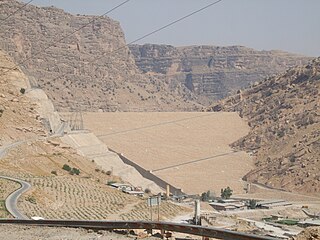
The Masjed Soleyman Dam is a dam in Iran on the Karun river. It is 177 metres (581 ft) high, has an installed capacity of 2,000 MW, and its reservoir holds 261,000,000 cubic metres (212,000 acre⋅ft) of water. The dam is a rock-fill structure with a vertical clay-core. The dam was built by Iran Water and Power Resources Development Co. and completed in 2002. The power station was built in two 1,000-MW stages. The first stage was complete in 2003 and the second in September 2007. The dam was named after the town of Masjed-Soleyman, about 25 kilometres (16 mi) away. The spillway gates are believed to be the largest of their kind in the world.

Upper Gotvand Dam, or simply the Gotvand Dam, is an embankment dam on the Karun River about 12 km (7.5 mi) northeast of Gotvand in Khuzestan Province, Iran. It currently has an installed capacity of 1,000 MW with another 1,000 MW in the works for a second phase. Studies for the project on Karun River began in the 1960s and specific designs on the Upper Gotvand were presented in 1967, 1975 and 1982. After the design and location were chosen, a further study was carried out in 1997. Preliminary construction began the same year. Besides the hydroelectric power production, the dam was also aimed at flood control. The river was diverted by April 2003 and excavation began soon thereafter. After completion of the dam, impounding of its reservoir began on 30 July 2011 during a ceremony attended by Iranian President Mahmood Ahmadinejad. The first generator of phase one was commissioned on 5 May 2012, two more by 18 September 2012 and the final in November 2012. Ahmadinejad was again present for the dam's inauguration on 22 April 2013. Phase 2 is estimated to be complete in 2015 and the dam is going to become one of Iran's largest power stations and is already its tallest earth-fill dam.
Khersan-3 dam is a hydroelectric arch dam currently under construction on the Khersan River, a tributary of the Karun River, in Iran. When complete it will have an installed capacity of 400 MW. It is situated near Atashgah in Chaharmahal and Bakhtiari Province and is a complementary dam to Khersan project along with the proposed Khersan-1 and Khersan-2 dams. Construction began in 2007 and it is expected to become operational in 2015.
Haffar is a canal in Iran.
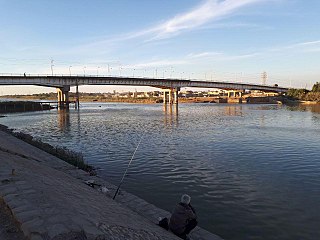
The Bahmanshir channel is a secondary estuary of the Karun River that parallels the Shatt al-Arab/Arvand Rud waterway on the far side of the Abadan Island, Iran, for 70 miles before emptying into the Persian Gulf.
Quruqchi Rud is a village in Ujan-e Gharbi Rural District, in the Central District of Bostanabad County, East Azerbaijan Province, Iran. At the 2006 census, its population was 376, in 82 families.

Iranrud which means Iran River in Persian, was a plan to build a canal from the Caspian Sea to the Persian Gulf. The former Soviet Union was eager to realize this project because its only warm water ports led to the Strait of Istanbul and the Dardanelles, which were under the control of Turkey, a NATO country.

The Simineh River, also known as the Tatavi Chay, is a river in northern Iran, arising in the Zagros Mountains of Kurdistan Province north of Saqqez, that flows into the south end of Lake Urmia. It is just over 200 kilometres (124 mi) long and has a catchment basin (watershed) of 2,090 square kilometres (810 sq mi). Its waters are used primarily for agriculture and the return flow significantly degrades its water quality.
The Khersan River is a 180km long tributary of the Karun River in Iran, flowing into an arm of the reservoir formed by the Karun-3 Dam. The Khersan-3 Dam is under construction, proposed to be the most upstream of a cascade of three dams.
















